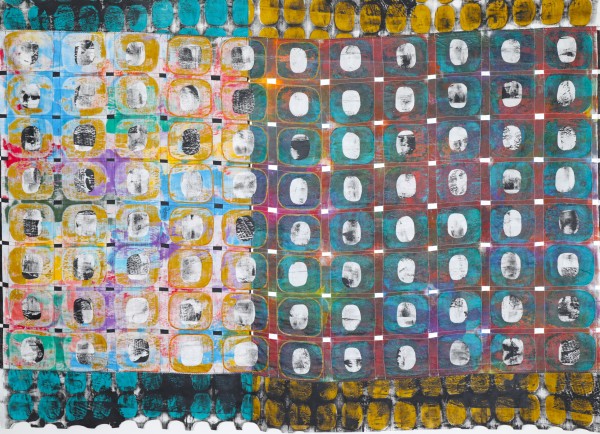Jeanne Williamson Ostroff is a mixed media artist who works mainly with fabric and is inspired by the grids and holes of orange construction fences. She has been sewing since childhood and studied textiles in art school. Her work has been exhibited widely in galleries, museums, and online. She has attended residencies at the Millay Colony for the Arts, Austerlitz, NY and the Vermont Studio Center, Johnson, VT. Licensed prints have been available at Crate & Barrel, Anthropologie, Annie Selke, and Pottery Barn. Her work is hanging in private homes, and hospital, corporate, and hospitality settings, and has been published in several books and magazines.
Her work is available through Saatchi Online, Artful Home, Artfully Walls, the deCordova Museum of Art Corporate Art Loan Program in Lincoln, MA, and is also on Geoform.
She has a BFA from Philadelphia College of Art (now the University of the Arts), where she majored in Fibers/Crafts. In addition to being trained as an artist, Jeanne has a MSAEd in Art Education from Massachusetts College of Art.
Jeanne lives in Natick, Massachusetts, with her husband Joshua Ostroff.
To learn more about Jeanne and her art, read her blog, follow her on Twitter and Instagram, visit her Facebook page, watch a short video about her work, and a longer version about her art and inspiration, read this interview on The World of Threads: Jeanne Williamson of Natick, Massachusetts, USA or this story in Women’s Activism.NYC.
Jeanne has also authored the how-to books, Uncommon Cards (Running Press, 2013), and The Uncommon Quilter (Potter Craft/Random House, 2007).
Statement
I am a mixed media artist who works with fabric. My mother taught me how to sew during my childhood, and I studied textiles in art school.
My artwork is a combination of printmaking, painting, and collage, on fabric. I am very interested in working with the different grid patterns of construction fences.
My interest in using construction fences started in 2002 when I started seeing different patterns, shapes, and sizes, as they were being used at many construction sites as a barrier to keep people safe by blocking off the site.
On hot days the fences can get limp and sag, and on cold days they sometimes crack and break. At times my use of the printed fence follows the grid, and at other times I like to break it apart, the same as can happen in the life of an actual construction fence.
After I monoprint the textures of fences on fabric, I also incorporate additional painting and collage techniques. I also often stitch the fabric by following the grids of the fence pattern.
The size of my work varies from as small as 6 inches to all the way up to 35 feet. I really enjoy creating work that is small to extremely large, and the challenges that come working in different formats.
For my wall pieces, I sometimes mount the fabric on boards, and other times the fabric is stiffened with matt medium so it looks like paper or plastic.
My installations are created using one piece of monoprinted fabric that is stiffened with matt medium which also makes it weather-proof. Some of my installation pieces have been exhibited outside for more than 18 months and do quite well after having full sun exposure, and after being rained and snowed on.
In my Loss Series, I tell my story about having had a mother had untreated mental health issues and how that affected me as a child and as an adult. After she died in 2021, I started in to incorporate hand embroidered fabrics I had found in her house, and on eBay, in my work. I incorporate pieces of monoprinted construction fence fabric as a metaphor for the boundaries I had to set with my mother, combined with the meticulously stitched and colorful vintage embroideries I acquired.
North Hill "Vibrant Living for People 65+" 865 Central Ave. Needham MA

